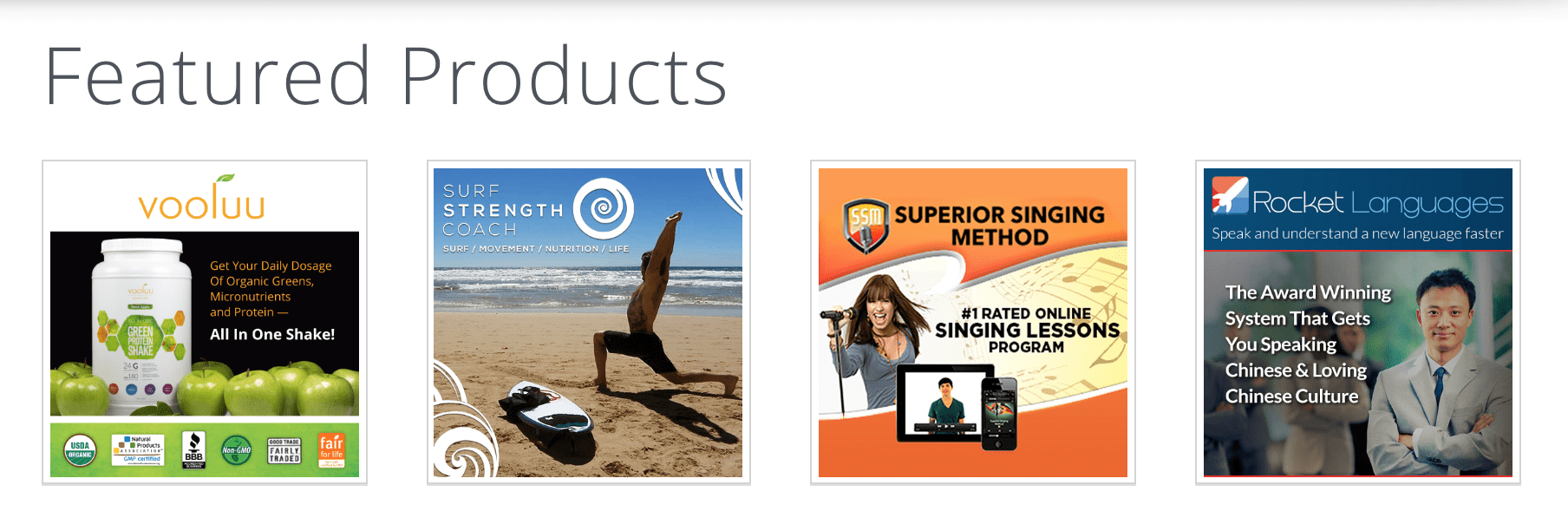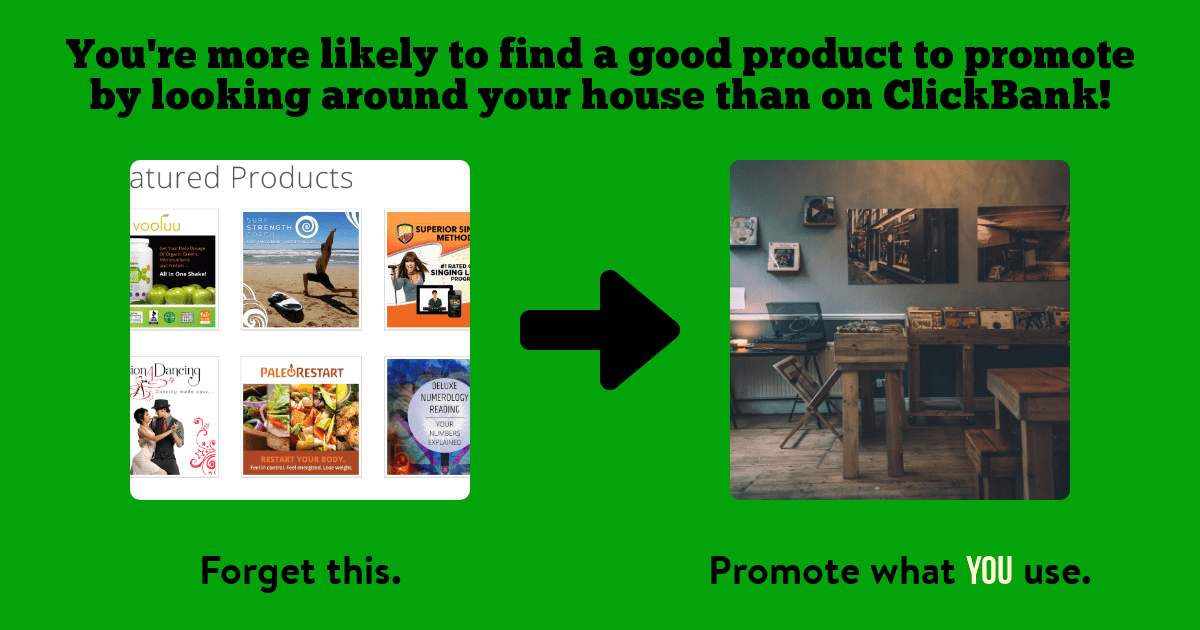Most people go about finding affiliate products to promote on their niche site the wrong way.
When looking for products that you can promote as an affiliate, the last thing you should do is browse affiliate marketing sites like ClickBank. While affiliate networks can be very useful when signing up for affiliate programs, they should not be the method you use to discover what products to promote!
If you’ve been following along with this series on affiliate marketing and building a successful niche site, then you already know that I advocate for filling your site with great content before you even think about trying to monetize it.
In this post, I’ll go into detail about why I think most people are looking for affiliate products in the wrong way and why focusing on products that you actually use is the much smarter, efficient, and ethical way to do things.
The Wrong Way To Look For Affiliate Products
Like I said in the intro, I believe that starting with an affiliate marketing site like ClickBank is the wrong way to look for affiliate products to promote.

This may come across as a big surprise – it’s the exact opposite of the advice most people are going to give you if you ask them where can I find affiliate products to promote?
In fact, when I did a search for how to find affiliate products to promote, the very first thing that came up was this…
To appreciate why I don’t like this approach, it helps to understand some big changes that are happening in the affiliate marketing world. These changes are why some people like to say affiliate marketing is dying and also why I personally think that there’s never been a better time to start a niche site and monetize with affiliate links.
It all depends on your perspective and what you are trying to achieve.
In the early days of affiliate marketing, pretty much anyone could rake in monumental profits by putting together a good sales page for an affiliate product they knew nothing about and driving traffic to that page via ads.
This process generally starts on the affiliate networks by sorting through products based on the commission percentages, conversion rates, and overall sales. Success used to be as simple as getting some good copy for the sales page, video, and ads.
Diet plans, supplements, and get rich quick schemes are the top money makers in this industry, and there are people out there who have made unbelievable amounts of money by putting up simple pages like the example below and pitching books, courses, coaching, and investments.

There are many legitimate products promoted in this way too, but many affiliates are indiscriminate regarding what they promote, and are just looking for what will pay them the most.
People still make money with these strategies, but when you hear people talk about whether affiliate marketing is dead, this is the type of affiliate site they are talking about.
The general public is more wary of scammy promotions, most ad networks have higher standards regarding what and how you can advertise, and it’s a lot more difficult to find products that an unaffiliated audience will actually buy from you.
Income generated using these old strategies also isn’t very sustainable for the same reasons. It’s a constant game of pumping a product until no more money can be made and then starting over from scratch.

Why Affiliate Marketing Via Niche Sites Is Different
The niche site approach that we’ve focused on in this series is very different from the above strategy.
Instead of trying to take as much value from viewers of your content as quickly as possible, you’re building a platform that allows you to give value in the form of information, entertainment, and insight.
The credibility that you gain from this is extremely valuable, and it provides you with a sustainable platform and audience that can generate income for many years.
As we’ll talk about in a future guide in this series, a niche site like this also provides many more monetization options than just affiliate recommendations. In the long run, you may even be able to offer your own products and leverage affiliates to promote it.
This is why I recommend focusing on picking a good niche and filling your site with great, helpful content before you worry too much about putting an affiliate link on it.
This method may take longer to turn a profit, but don’t mistake that for meaning that you can’t make a lot of money. Over the long term, you’ll make more money with this approach and be happier with what you are creating.
Another bonus is that over time, the niche site approach requires less and less time to continue generating money. The old way of affiliate marketing involves regularly starting over from scratch once a product is no longer generating money. With a niche site, the content you create is generally relevant for many years and it’s easy to keep it updated.
The Right Way To Find (And Promote) Affiliate Products
If you’ve followed my advice for choosing a niche and creating good content, then finding products to recommend is as simple as looking around at what you actually use (or would use) in the course of doing the things you talk about on your site.
This method of choosing products to promote may seem dead simple – and that’s because it is.
You don’t have to make it more complicated than that.
In fact, you shouldn’t make it more complicated than that.
There are many benefits to this approach, and they mostly center around the fact that you are giving honest recommendations that you believe in. They’ll be…
- Easier to make.
- More compelling.
- More likely to help your visitors.
They’re also more likely to make you money because of the above reasons too.
You might be worried that you won’t be able to find enough products in your niche to promote as an affiliate. While you have to get creative for some niches, the vast majority of them will have plenty of great options.
Here’s how to come up with product ideas.
Start with creating content that actually helps people. When you are creating or reviewing that content, think about the products that you use (or would use) in the process of doing the things you talk about.
An important point here is that you shouldn’t aim to fill all your posts with affiliate links. In fact, most of them probably shouldn’t include any affiliate links at all. Your number one goal should remain at all times to provide the best information possible. Inserting an affiliate link should not get in the way of that. Only do it when the recommendation aligns with what you want to talk about.
By following that advice, you can avoid becoming one of the many people who tries to start a niche site and then wonders why no one likes their content and why no one clicks their links. All niche sites are not created equal, and adding more affiliate links is rarely the route to increasing your income when you’re just getting started.
Here’s a good “rule” I like to use when thinking about adding an affiliate link:
Ask yourself if you would make that same product recommendation if you were having a conversation with a friend about the topic rather than writing a blog post. If the answer is no, drop the link.
If you follow this advice, over time you’ll notice that your site will develop some high-value pages and some that don’t have any income-generating potential at all.
A good tactic to increase income at this point without lowering the quality of your other posts is to link to the high-value pages at the end of blog posts (or sometimes even within them) as further reading. This allows you to add value and increase income without diluting the quality of your posts with product recommendations.
A great example of this in action is the Resources page for this blog. People ask me about the tools I use in my business all the time, and it often makes sense to talk about them. Having the resource page allows me to share that information with readers without having to discuss it in all my posts.
When you are just getting started, you may want to start a Google Doc and brainstorm as many products, services, books, and courses that would help your audience with the things you are helping them with.
Don’t worry about whether the product or service has an affiliate program at this stage – just list anything that comes to mind that could help.

Once you have a good list, you can start looking for the affiliate programs.
Finding The Affiliate Programs
Finding affiliate programs for a product or service is usually very easy.
I’ve found that the fastest way to match a product with an affiliate program is a couple of Google searches.
For retail products that are available in more than one place, it’s generally easiest to just search for the product like you want to buy it and then look through the top search results. These websites all have affiliate programs that you can sign up for:
- Amazon
- eBay
- Walmart.com
- Wayfair
- Target
- Jet
- Home Depot
- Lowe’s
- Chewy
That’s not a complete list, but that should give you an idea of just how many sites out there offer affiliate programs.
Most people never make it further than becoming an affiliate of Amazon for retail products because they offer so many products and many people prefer shopping there anyway.
If you are looking to promote something that is only sold directly through a specific website or brand, then your best bet is to search for the brand or website plus “affiliate program” or “partner”. This is how you would find affiliate programs for things like software, courses, or services.
When you are dealing directly with businesses, you’ll find that many of them use the traditional affiliate marketing networks to manage their affiliate programs. Don’t be surprised if they ask you to set up accounts at places like ClickBank, Rakuten, or ShareASale.
When should you start adding affiliate links to your site?
Most people who start niche sites rush to add affiliate links too early.
I understand the desire to start making money, but when you don’t even have traffic yet, affiliate links are just getting in the way.
Another big problem is that most affiliate programs don’t want low-quality sites promoting their products. If you apply for an affiliate program but don’t actually drive any traffic or sales, there’s a very good chance they will drop you, or won’t approve you in the first place.
For this reason, I recommend waiting several months after starting your site before you seriously consider putting up posts that have affiliate links. You should have some posts reliably ranking on Google and regular traffic before you add the links. The only exception to this is if your post needs a link to this product either way. If in the process of sharing your content you need to link to that product, then if an affiliate link is available you might as well use it. But if the link is forced in any way, leave it out initially.
How much money can you make promoting affiliate products this way?
One of the main questions people have about affiliate marketing is ‘how much can I make as an affiliate?’
The answer is anywhere from absolutely nothing to millions – your ultimate success is going to be highly dependent on the niche you choose and the quality of the content you create.
With that being said, the vast majority of good niches have the potential to generate between 4 and 5 figures a month just through affiliate marketing.
Many people make reaching $1000 per month a goal to reach by the end of their first year, although for some people it will take longer than this and others will hit that mark much sooner. Generally speaking though, the older your site gets, the more it will make (up to a certain point) because your reach and authority will continue to grow.
What should you do next?
If your niche site is already full of great content and you’re getting traffic, then you should plan on doing the product brainstorming as soon as possible and getting some links up.
If you don’t have regular traffic, then you should continue focusing all of your efforts on creating great content. Here is the post that shares my strategies for picking good topics to write about in case you missed it.
If you haven’t read any of the posts in this affiliate marketing series yet, go back to the introduction and read through each one.
Here are links to each post in case you want to go straight to a specific one:
How to Build a Niche Site for $35
11 Free Ways to Drive Traffic to Your New Site
If you have any questions, ask in the comments below!




Blogging. If you have joined the best affiliate programs and looking for ways to promote the product or service, blogging is the and effective way.